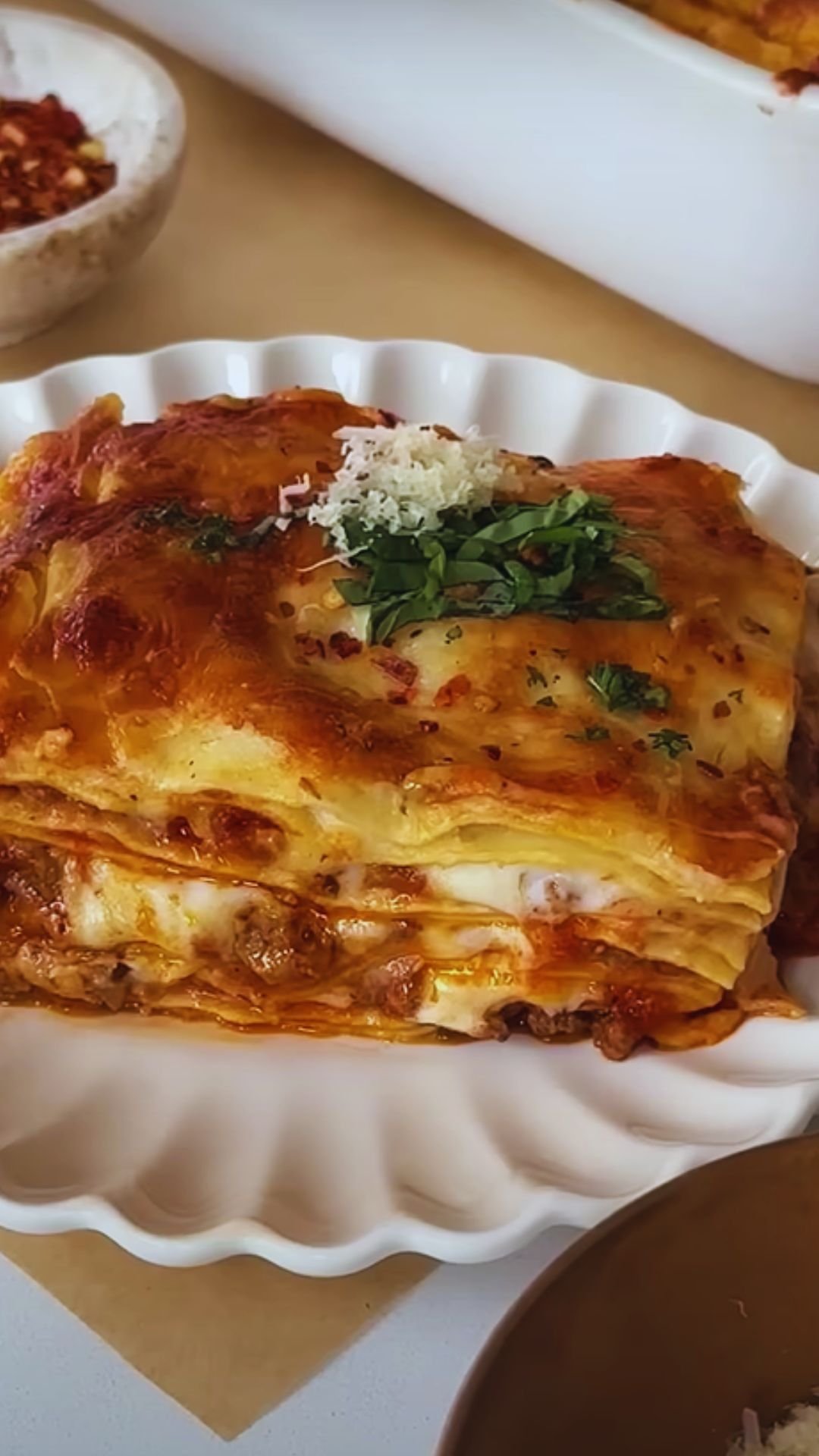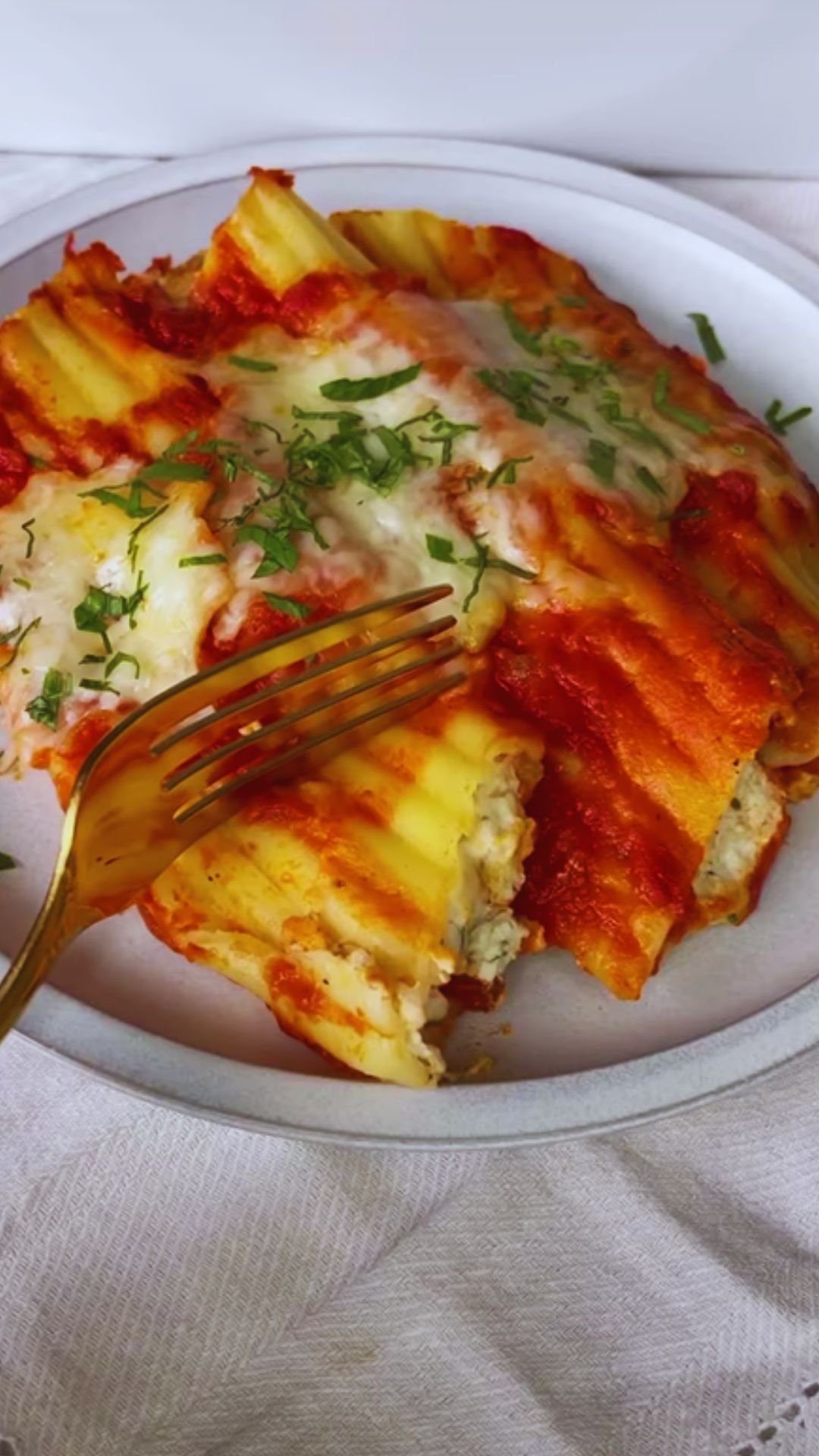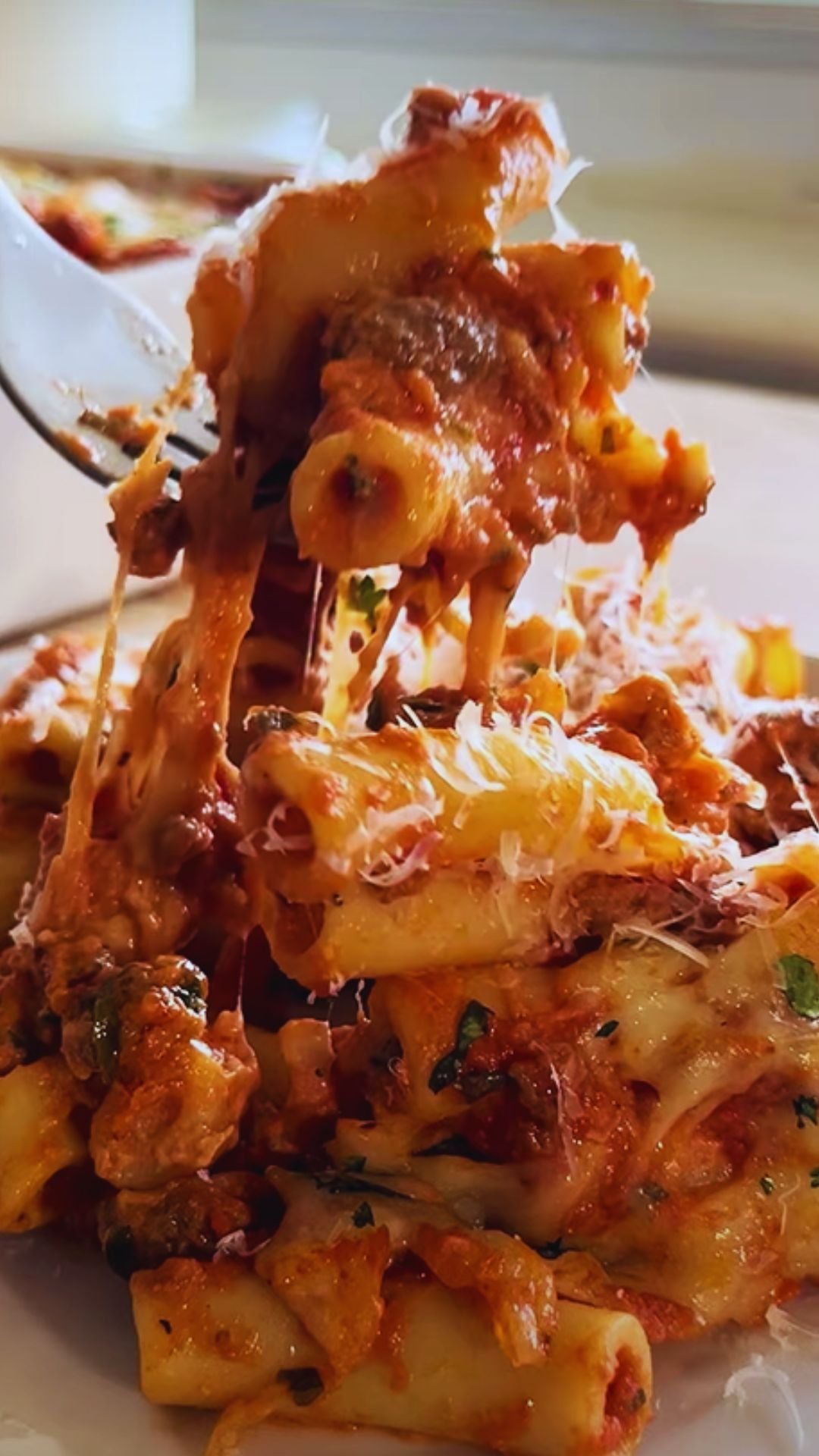There’s something magical about those recipes that get passed down through generations. They carry not just flavors, but memories, stories, and a certain kind of love that you can almost taste. That’s exactly what this sour cream lasagna recipe is for me – a portal to Sunday dinners at my grandmother’s house, where the aroma of bubbling tomato sauce and melting cheese would fill every corner.
I remember watching my grandmother’s hands as they moved with practiced precision, layering pasta, spreading her special sour cream mixture, and sprinkling just the right amount of cheese. “The secret,” she would tell me with a wink, “is in the sour cream. It makes everything creamier than you can imagine.”
Years later, when I first attempted to recreate this dish in my own kitchen, I realized that Grandma wasn’t exaggerating. The sour cream transforms an ordinary lasagna into something extraordinary – silky, tangy, and incredibly comforting. It cuts through the richness of the meat sauce and complements the cheese in a way that makes each bite perfectly balanced.
So today, I’m sharing this treasured recipe with you. It’s more than just a meal; it’s a piece of my family history that I hope will become a favorite in your home too.
Why This Sour Cream Lasagna Stands Out
Before we dive into the recipe, let me tell you why this isn’t just another lasagna recipe you’ll find online:
- The sour cream layer creates an unmatched creamy texture that traditional ricotta can’t deliver
- The homemade meat sauce develops deep flavors without requiring hours of simmering
- The layering technique ensures every bite has the perfect balance of pasta, sauce, and cheese
- It reheats beautifully, making it ideal for meal prep or family gatherings
- The recipe is surprisingly forgiving – even novice cooks can achieve impressive results
Ingredients You’ll Need
For the Meat Sauce:
- 2 tablespoons olive oil
- 1 large onion, finely diced
- 4 garlic cloves, minced
- 2 pounds ground beef (80/20 lean-to-fat ratio)
- 1 pound Italian sausage, casings removed
- 2 cans (28 ounces each) crushed tomatoes
- 1 can (6 ounces) tomato paste
- 2 tablespoons dried oregano
- 2 tablespoons dried basil
- 1 tablespoon sugar
- 2 bay leaves
- 1 teaspoon salt
- 1/2 teaspoon black pepper
- 1/4 teaspoon red pepper flakes (optional)
For the Sour Cream Mixture:
- 16 ounces full-fat sour cream
- 2 large eggs
- 1/4 cup fresh parsley, chopped
- 1/2 teaspoon garlic powder
- 1/2 teaspoon salt
- 1/4 teaspoon black pepper
For Assembly:
- 1 pound lasagna noodles (traditional, not no-boil)
- 4 cups shredded mozzarella cheese
- 2 cups freshly grated Parmesan cheese
- Fresh basil leaves for garnish
The Secret Behind Perfect Homemade Meat Sauce
The foundation of any great lasagna is a robust, flavorful meat sauce. While my grandmother would sometimes simmer her sauce for an entire day, I’ve adapted her technique to create equally deep flavors in a fraction of the time.
The key is in building layers of flavor:
- Start with aromatics – Sautéing onions and garlic until translucent releases their essential oils and creates a flavor base
- Brown the meat properly – Allow the meat to develop a deep brown crust before breaking it up; this creates those complex, savory flavors known as the Maillard reaction
- Use two types of meat – The combination of ground beef and Italian sausage provides a perfect balance of richness and spice
- Don’t rush the simmer – Even a relatively short 30-minute simmer allows the flavors to meld beautifully
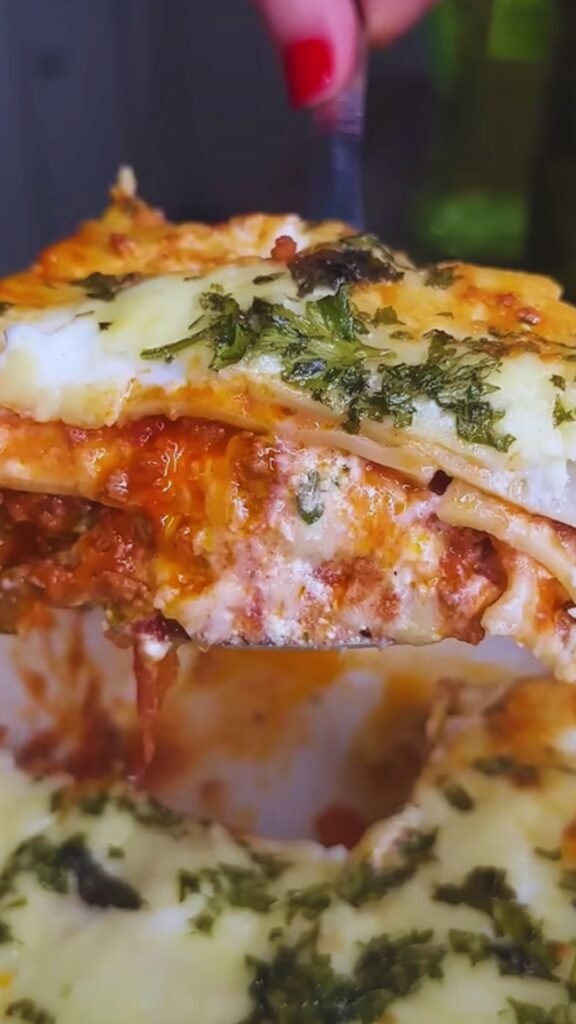
Step-by-Step Cooking Instructions
Preparing the Meat Sauce:
- Heat olive oil in a large, heavy-bottomed pot over medium heat
- Add diced onion and cook until translucent, about 5 minutes
- Add minced garlic and cook for another 30 seconds until fragrant
- Increase heat to medium-high and add ground beef and Italian sausage
- Cook meat, breaking it up with a wooden spoon, until well-browned (about 8-10 minutes)
- Drain excess fat if necessary, leaving about 2 tablespoons in the pot
- Add crushed tomatoes, tomato paste, dried herbs, sugar, bay leaves, salt, pepper, and red pepper flakes
- Stir well to combine, then reduce heat to low
- Simmer uncovered for 30 minutes, stirring occasionally
- Remove bay leaves and adjust seasoning to taste
- Set aside while preparing other components
Preparing the Sour Cream Mixture:
- In a medium bowl, combine sour cream and eggs, whisking until smooth
- Add chopped parsley, garlic powder, salt, and pepper
- Mix thoroughly and set aside
Cooking the Pasta:
- Bring a large pot of salted water to a boil
- Cook lasagna noodles according to package directions, but reduce cooking time by 2 minutes (they should be very al dente)
- Drain noodles and rinse with cold water to stop cooking
- Lay noodles flat on kitchen towels to prevent sticking
Assembling the Lasagna:
- Preheat oven to 375°F (190°C)
- Lightly grease a 9×13-inch baking dish
- Spread 1 cup of meat sauce on the bottom of the dish
- Arrange a layer of noodles over the sauce, slightly overlapping
- Spread 1/3 of the remaining meat sauce over the noodles
- Dollop 1/3 of the sour cream mixture over the meat sauce and gently spread
- Sprinkle with 1 cup mozzarella and 1/3 cup Parmesan
- Repeat layers twice more, ending with a final layer of noodles
- Top with remaining mozzarella and Parmesan cheese
Baking:
- Cover baking dish tightly with aluminum foil
- Bake for 25 minutes
- Remove foil and bake for an additional 25 minutes until bubbling and golden brown
- Remove from oven and let stand for 15 minutes before serving
- Garnish with fresh basil leaves

The Science Behind Great Lasagna
Understanding a few culinary principles can elevate your lasagna from good to exceptional:
Protein Content in Cheese
Different cheeses serve different purposes in lasagna. The protein structure of mozzarella allows it to stretch and create those desirable cheese pulls, while Parmesan provides umami and salt due to its aging process.
Starch Gelatinization in Pasta
Cooking the pasta properly is crucial. The starch in pasta undergoes gelatinization when cooked, absorbing water and becoming tender. By undercooking the pasta slightly before baking, we prevent it from becoming mushy in the final dish.
Collagen Breakdown in Meat
The long, slow cooking of the meat sauce breaks down collagen in the meat, transforming it into gelatin. This creates the rich, silky texture that clings to the pasta.
Acid-Dairy Balance
The acidity of tomatoes can sometimes cause dairy to curdle. The addition of eggs in the sour cream mixture creates a stable emulsion that prevents separation during baking.
Nutritional Information
While this lasagna is certainly indulgent, it’s helpful to understand its nutritional profile:
| Nutrient | Amount per Serving | % Daily Value |
|---|---|---|
| Calories | 485 | – |
| Total Fat | 28g | 36% |
| Saturated Fat | 14g | 70% |
| Cholesterol | 120mg | 40% |
| Sodium | 890mg | 37% |
| Total Carbohydrates | 32g | 11% |
| Dietary Fiber | 3g | 12% |
| Sugars | 7g | – |
| Protein | 29g | 58% |
| Calcium | 420mg | 42% |
| Iron | 3.5mg | 19% |
| Potassium | 580mg | 12% |
| Vitamin A | 1200IU | 24% |
| Vitamin C | 15mg | 25% |
Based on a 2,000 calorie diet. Values are approximate and based on standard ingredients.
Make-Ahead and Storage Tips
One of the beauties of this lasagna is how well it works for meal planning:
Make-Ahead Options:
- Assemble and refrigerate: You can assemble the entire lasagna up to 24 hours before baking. Cover tightly with plastic wrap and refrigerate. Allow it to sit at room temperature for 30 minutes before baking.
- Freeze before baking: Assemble the lasagna in a freezer-safe dish, cover tightly with plastic wrap and aluminum foil, and freeze for up to 3 months. Thaw overnight in the refrigerator before baking.
- Prepare components separately: The meat sauce can be made up to 3 days ahead and stored in the refrigerator, or frozen for up to 3 months.
Storage and Reheating:
- Refrigerate leftovers: Store cooled leftovers in an airtight container for up to 4 days.
- Freezing leftovers: Cut cooled lasagna into individual portions, wrap each in plastic wrap and aluminum foil, and freeze for up to 2 months.
- Reheating from refrigerated: Cover with foil and reheat in a 350°F (175°C) oven for 20-25 minutes, or microwave individual portions on medium power.
- Reheating from frozen: Thaw overnight in the refrigerator if possible, then reheat as above. If reheating directly from frozen, bake covered at 350°F (175°C) for about 1 hour.
Variations to Try
While I believe my grandmother’s recipe is perfect as is, here are some thoughtful variations that stay true to the spirit of the original:
Vegetable-Boosted Version:
Add 2 cups of finely diced vegetables (like bell peppers, zucchini, and carrots) to the sauce for extra nutrition.
Spinach Addition:
Mix 10 ounces of thawed, well-drained frozen chopped spinach into the sour cream mixture for a pop of color and nutrients.
Three-Cheese Upgrade:
Add 1 cup of ricotta cheese to the sour cream mixture for an even more indulgent texture.
Herb-Infused:
Double the fresh herbs and add 2 tablespoons of fresh thyme for a more aromatic profile.
Spicy Version:
Double the red pepper flakes and add 1 diced jalapeño to the sauce for heat lovers.
Serving Suggestions
To create a complete meal around this spectacular lasagna, consider these complementary sides:
- Classic garlic bread: The crispy texture contrasts beautifully with the soft lasagna
- Simple green salad: A light, acidic dressing helps cut through the richness
- Roasted vegetables: Try broccoli or Brussels sprouts with a light olive oil and lemon dressing
- Antipasto platter: For a true Italian feast, start with olives, cured meats, and marinated vegetables
- Sparkling water with lemon: The effervescence cleanses the palate between bites
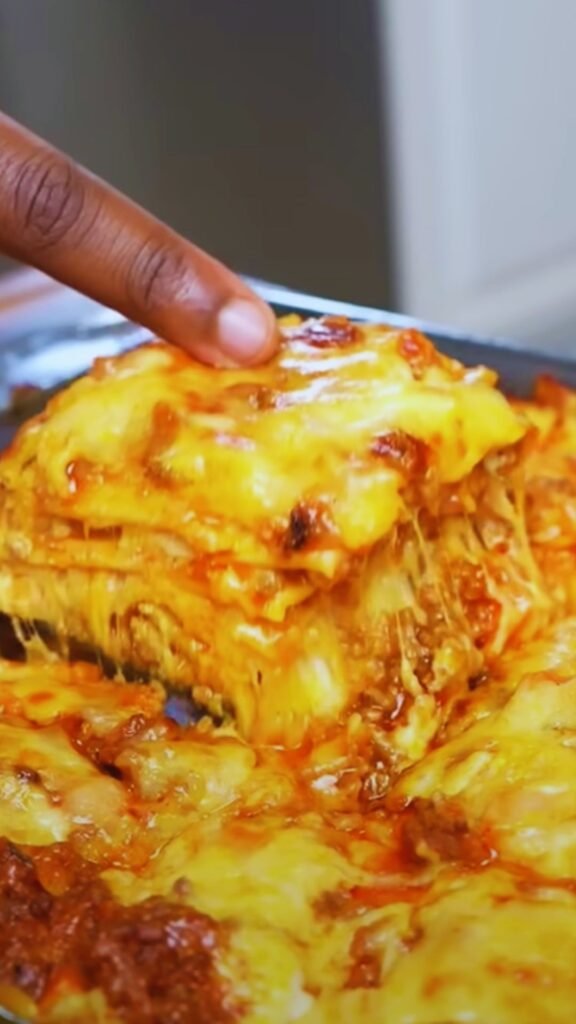
Troubleshooting Common Issues
Even experienced cooks can encounter challenges with lasagna. Here’s how to address them:
Watery Lasagna:
- Cause: Excess moisture in ingredients or insufficient cooling time
- Solution: Ensure meat sauce is thick, drain noodles well, and allow lasagna to rest for at least 15 minutes before cutting
Dry Lasagna:
- Cause: Too little sauce or overcooking
- Solution: Ensure adequate sauce in each layer and don’t exceed recommended baking time
Curdled Sour Cream:
- Cause: High heat or insufficient stabilization
- Solution: Never skip the eggs in the sour cream mixture, and make sure the sauce isn’t boiling hot when assembling
Broken Cheese Layer:
- Cause: Using pre-shredded cheese with anti-caking agents
- Solution: Always grate your own cheese for the smoothest melt
Burnt Top:
- Cause: Oven too hot or positioning too close to heating element
- Solution: Cover with foil if top is browning too quickly
Questions & Answers
Q: Can I use no-boil lasagna noodles instead?
Yes, you can use no-boil noodles, but you’ll need to adjust the recipe slightly. Add an extra 1/2 cup of water to the meat sauce and make sure each noodle is completely covered with sauce during assembly. The final texture will be slightly different from the original recipe.
Q: Is it possible to make this lasagna vegetarian?
Absolutely! Replace the meat with 2 pounds of sautéed vegetables like mushrooms, zucchini, eggplant, and bell peppers. Add 1 cup of lentils to the tomato sauce for protein and a meaty texture. The sour cream layer works perfectly in a vegetarian version.
Q: Can I reduce the fat content in this recipe?
You can make a lighter version by using lean ground turkey instead of beef, reducing the cheese by one-third, and using low-fat sour cream. However, the texture and flavor will be noticeably different. I recommend trying the original recipe once before making modifications.
Q: Why do you add sugar to the sauce?
A small amount of sugar helps balance the acidity of the tomatoes, resulting in a more rounded flavor profile. If you prefer, you can omit it or substitute with a grated carrot, which adds natural sweetness.
Q: How can I tell when the lasagna is fully cooked?
The lasagna is done when it’s bubbling around the edges, the cheese on top is golden brown, and a knife inserted in the center comes out hot. If you have an instant-read thermometer, the internal temperature should reach 165°F (74°C).
Q: Can I assemble this in two smaller pans instead of one large one?
Yes! This recipe divides perfectly between two 8×8-inch pans. Freeze one for later use, or share with someone who could use a home-cooked meal.
Q: My family doesn’t like Italian sausage. What can I substitute?
You can use all ground beef instead, or try ground pork or even ground turkey with added seasonings. If using a leaner meat, consider adding an extra tablespoon of olive oil to maintain richness.
Q: How important is the resting time after baking?
Very important! The resting time allows the lasagna to set up properly, making it easier to slice and serve. It also allows the flavors to settle and intensify. Don’t skip this step, even if you’re tempted by the amazing aroma!
Final Thoughts
There’s something deeply satisfying about creating a dish that connects generations. Each time I make this sour cream lasagna, I feel my grandmother’s presence in the kitchen with me, nodding approvingly as I layer the noodles or taste the sauce for seasoning.
The beauty of this recipe isn’t just in its incredible flavor and texture – though those are certainly remarkable – but in its ability to bring people together. I’ve served this lasagna at holiday gatherings, taken it to potlucks, delivered it to new parents, and presented it as the centerpiece of intimate dinner parties. Without fail, it sparks conversation, creates memories, and leaves everyone asking for the recipe.
If you’re looking for a dish that truly impresses while providing the deep comfort of homemade goodness, this sour cream lasagna delivers in every way. Yes, it takes a bit of time and effort, but the result is so much more than just a meal – it’s an experience, a tradition, and perhaps even the beginning of your own family food legacy.
I hope you’ll give this recipe a try and make it your own. Who knows? Perhaps decades from now, someone in your family will be writing about “Grandma’s sour cream lasagna” and the memories it helped create around your table.
